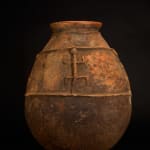Bambara Terracotta Jidaga (Water Container), 20th Century CE
Terracotta
height 47.6 cm
height 18 3/4 in
height 18 3/4 in
DE.029 (LSO)
Further images
This blackened terra cotta water container comes to us from the Bamana peoples of Mali. Bamana potters, who are most often women, form the base of these containers by gently...
This blackened terra cotta water container comes to us from the Bamana peoples of Mali. Bamana potters, who are most often women, form the base of these containers by gently pounding a flattened pancake of clay over a convex mold with a stone or fired clay tamper; usually, the mold is an old or broken pot that has been saved for this purpose.
To achieve a rich black color, the potter removes the jug from the fire and immediately smokes it in a pile of sawdust, peanut shells, millet, or rice chaff. She then plunges it, still burning hot, into a tree- bark bath, in order to seal and further blacken it. Due to the intended use for public display, medium-sized water containers are among the most decorative and varied wares created by the Bamana potters. They are often placed prominently in a family compound, within easy reach under a tree or near a veranda.
Water containers such as this are embellished with modeled imagery of humans and animals, such as this one, which shows lizards, a common motif on Bamana water containers. The lizards are rendered in low relief, legs outspread and bodies draped as if suspended from the ridge that encircles the pots shoulders. Pencil thin ridges define three distinct zones, the bottom zone features a rough texture applied as the potter molded the clay over a convex form using a heavy block covered by a netted cloth.
This is an attractive piece of African secular art.
To achieve a rich black color, the potter removes the jug from the fire and immediately smokes it in a pile of sawdust, peanut shells, millet, or rice chaff. She then plunges it, still burning hot, into a tree- bark bath, in order to seal and further blacken it. Due to the intended use for public display, medium-sized water containers are among the most decorative and varied wares created by the Bamana potters. They are often placed prominently in a family compound, within easy reach under a tree or near a veranda.
Water containers such as this are embellished with modeled imagery of humans and animals, such as this one, which shows lizards, a common motif on Bamana water containers. The lizards are rendered in low relief, legs outspread and bodies draped as if suspended from the ridge that encircles the pots shoulders. Pencil thin ridges define three distinct zones, the bottom zone features a rough texture applied as the potter molded the clay over a convex form using a heavy block covered by a netted cloth.
This is an attractive piece of African secular art.







